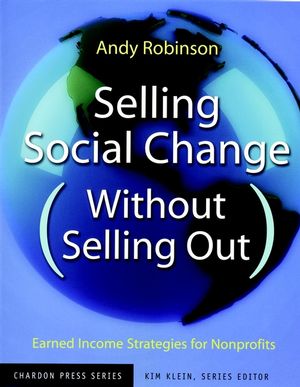Selling Social Change (Without Selling Out): Earned Income Strategies for NonprofitsISBN: 978-0-7879-6216-6
Paperback
256 pages
April 2002, Jossey-Bass
 This is a Print-on-Demand title. It will be printed specifically to fill your order. Please allow an additional 10-15 days delivery time. The book is not returnable.
|
||||||
Acknowledgments.
The Author.
The Contributors.
1. SELLING YOUR CAUSE WITHOUT SELLING OUT.
We?re all in sales.
Commerce, not capitalism.
CASE STUDY: Bad Jokes, Great Service: Our Community Bikes.
2. HOW EARNED INCOME CAN BENEFIT YOUR MISSION.
Earned income: It?s a Movement.
The value of funding Diversity.
The pros and cons of earned Income.
Balancing Mission and Money: Resource Center of the Americas.
Beyond T-shirts and coffee Mugs.
CASE STUDY: Flavors of the Desert: Native Seeds/SEARCH.
3. CREATING AN ENTERPRISING NONPROFIT.
The enterprise Advocate.
The venture committee, the board, and the Staff.
Recruiting for Enterprise: Grassroots Leadership.
Finding and using outside help.
Knowing what your work costs.
Worksheet 3.1. Are you ready for Enterprise?
CASE STUDY: Capitalism with a Conscience: Global Exchange.
4. CHOOSING YOUR NEW VENTURE.
The Brainstorming Process.
Worksheet 4.1. Brainstorming your New Venture.
Location, Location, Location: Burns Bog Conservation Society and Plateau Restoration.
Selecting the right Venture.
Worksheet 4.2. Evaluating your earned Income Ideas.
Powerful Publications.
Think retail Last.
How to do Market Research.
Worksheet 4.3. Market Research.
How to think about Pricing.
Conducting a Feasibility Study.
Getting to ?no?.
CASE STUDY: The Power of the Footnote: DataCenter.
5. DEVELOPING A BUSINESS PLAN FOR SOCIAL CHANGE.
A matter of Scale.
How to use a Business Plan.
Who writes the Plan?
Components of a Business Plan.
Worksheet 5.1. Preparing a Business Plan.
Writing the Plan:White Earth Land Recovery Project?Native Harvest.
CASE STUDY: How to Build a Working Neighborhood: Esperanza Unida.
6. FINDING CAPITAL TO LAUNCH YOUR VENTURE.
Internal and informal Sources of Funds.
External Sources.
The coldly Analytical Cheerleader.
Creative Financing: Palouse-Clearwater Environmental Institute.
Worksheet 6.1. Finding Start-up Funding.
CASE STUDY Reclaiming History/Reclame La Historia: SouthWest Organizing Project.
7. MARKETING YOUR MISSION.
Market Segmentation.
The Nonprofit Niche: Institute for Conservation Leadership and Technical Assistance for Community Services.
Creating and using a Marketing Plan.
Sample Marketing Plan: Esperanza Unida.
Promotion options for Grassroots Groups.
Media Savvy: Melpomene Institute.
Worksheet 7.1. Creating a Marketing Plan.
Worksheet 7.2. Marketing Calendar.
CASE STUDY Crossing Borders: BorderLinks.
8. CONSIDERING CORPORATE PARTNERSHIPS by Jennifer Lehman.
The Nuts and Bolts of Corporate Relationships.
Be Wary.
Customize your Marketing Plan.
Corporate Contracts and Cause-Related Marketing: Melpomene Institute.
Do your homework on Potential Partners.
Corporations do their Homework, Too.
Wholesaling to Businesses:Women?s Bean Project.
From plan to Action.
Keep the Relationship on Track.
A Sampling of Other Nonprofits with Corporate Relationships.
Evaluate your results and Share the News.
CASE STUDY Off the Streets, Into the Kitchen: FareStart.
9. NAVIGATING THE TAX IMPLICATIONS OF EARNED INCOME by Terry Miller.
The Commerciality standard and the notion of unrelated Business Income.
Scale of the Venture.
Revenue versus Support.
Current areas of Scrutiny, Enforcement, and Dispute.
Public charity status: The Public Support Tests.
Creating a taxable Subsidiary Corporation.
CASE STUDY ?Our Profit Is Our Vegetables?: The Food Bank of Western Massachusetts.
10. MANAGING AND EXPANDING YOUR VENTURE.
Retaining and Retraining Staff.
Outsourcing: Expanding your Talent Pool.
Repackaging your work for new Markets and Larger Sales.
Working with competitors to Expand the Market.
Managing Supply and Demand.
Second-stage Financing.
The value of Modest Expectations.
CASE STUDY Radical Self-Defense: The Center for Anti-Violence Education.
11. WHEN BAD VENTURES HAPPEN TO GOOD GROUPS.
Case Example: Institute for Local Self-Reliance.
Case Example: Oregon Fair Share.
Case Example: Our Community Bikes.
Case Example:The Food Bank of Western Massachusetts.
CASE STUDY Food and Power: Georgia Citizens Coalition on Hunger.
12. LESSONS LEARNED ALONG THE WAY.
Top tips for Earned Income.
The cash register is the Voting Booth.
Notes.
Resources.
Quick Index: Earned Income Strategies for Nonprofits.
Index.



